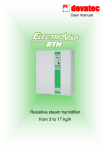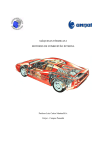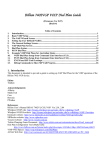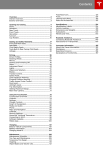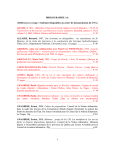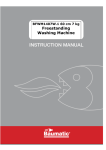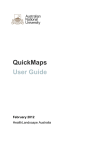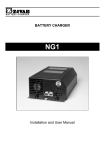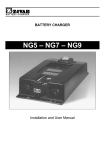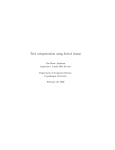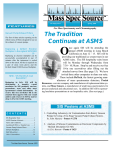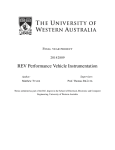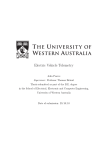Download Jonathan Oakley Thesis _20148511
Transcript
Evaluating Electric Vehicles A dissertation submitted as partial requirement for the degree of Bachelor of Engineering in Electrical and Electronic Engineering at the University of Western Australia. Jonathan Oakley - 20148511 Supervisor: Professor Thomas Bräunl Date of Submission: 3rd of June 2011 Abstract Conventional road transport is powered by non-renewable hydrocarbon fuels and is a major contributor to green house gas emissions. These factors have raised global interest in electric alternatives. Several large manufacturers are starting production of completely electric cars. Currently the performance and range of these vehicles is measured using standardised tests. These methods have been adapted from the speed profile testing used to measure fuel economy and emission levels in internal combustion powered vehicles. Research suggests that such testing does not accurately describe economy or emissions in real driving conditions. The aim of this project was to assess the performance of the electric vehicles produced by the Renewable Energy Vehicle project by conducting the standardised tests and comparing them to real world driving conditions. Real world testing under a variety of conditions was completed. Some speed profile testing was completed on a test track and chassis dynamometer. The results from speed profile testing suggest that the standardised tests are overestimating energy consumption. The real world results have shown large energy consumption increases for accessory usage and high traffic scenarios that are not tested using standard procedures. 3 Acknowledgements I would like to formally acknowledge the following people, whose assistance and help have made this project possible. Firstly I would like to thank my supervisor Professor Thomas Bräunl for his support and guidance throughout the year. I would like to thank all the members of the REV project, past and present. I am particularly grateful to Ian Hooper, John Pearce, Beau Trepp and Ivan Neubronner for their advice and knowledge. Also a special thanks to Yiwei Lui who helped with some of the test drives. I really appreciated the assistance from the Electrical Engineering Workshop staff, especially Ken Fogden. Their willingness to assist whenever possible was very helpful. I would like to thank Rob Mason and the rest of the staff at EV Works Pty Ltd for keeping the car on the road and allowing me to help with repairs. I really enjoyed doing some practical work. I would also like thank the people at DTEC and Polytechnic West for allowing me to use their facilities. Finally I would like to express my gratitude to my partner Stephanie for keeping me sane. 4 List of Figures Figure 1.1: REV Economy Getz Figure 1.2: REV Performance Lotus Figure 2.1: New European Drive Cycle Speed Profile Figure 2.2: FTP-75 Drive Cycle Speed Profile Figure 2.3: Japan 10-15 Drive Cycle Speed Profile Figure 2.4: JC08 Drive Cycle Speed Profile Figure 2.5: LiFePO4 Discharge Capacity at Different Current Loads Figure 3.1: Fuel Consumption Label Figure 3.2: ADR 81/02 Speed Profile Figure 3.3: Test Program GUI Figure 3.4: TBS Battery Monitor Figure 3.5: City Test Route 26.6km Figure 3.6: Highway Test Route 27.7km Figure 4.1: Urban Cycle GPS Track Figure 4.2: REV Getz Mean Power Consumption with Standard Deviation Error Bars Figure 4.3: REV Getz Mean Speed with Standard Deviation Error Bars Figure 4.4: City Route Peak and Off Peak Speed Profile Figure 4.5: Highway Route Peak and Off Peak Speed Profile Figure 4.6: REV Getz Power Supplied to the Battery verses Time Figure 4.7: REV Getz Accumulated Energy Supplied to the Charging System Figure 4.8: REV Lotus Power Supplied to the Battery verses Time Figure 4.9: REV Lotus Accumulated Energy Supplied to the Charging System Figure 5.1: REV Getz Consumption Percentage Increase Over City Off-Peak Mean List of Tables Table 2.1: Test Cycles Table 2.2: Production Electric Vehicles Table 4.1: Speed Profile Testing Results Table 4.2: Automatic Getz ADR 81/02 Fuel Consumption 5 Nomenclature AC Alternating Current ADR Australian Design Rule DC Direct Current DTEC Driver Training and Education Centre EV Electric Vehicle FTP Federal Test Procedure GPO General Power Outlet GPS Global Positioning System GUI Graphical User Interface ICE Internal Combustion Engine IDEAL Intelligently Designed Engineering for Advanced Living NEDC New European Driving Cycle REV Renewable Energy Vehicle USB Universal Serial Bus UWA University of Western Australia 6 Contents 1 Introduction ...................................................................................................................... 10 1.1 Project Aims .............................................................................................................. 10 1.2 Test Vehicles ............................................................................................................. 10 1.2.1 REV Getz ........................................................................................................... 11 1.2.2 REV Lotus ......................................................................................................... 11 1.3 2 Background and Literature Review .................................................................................. 13 2.1 Basics of Profile Testing ........................................................................................... 13 2.2 Electric Vehicle Range Calculation .......................................................................... 13 2.3 Common Testing Procedures .................................................................................... 14 2.3.1 New European Driving Cycle ............................................................................ 14 2.3.2 Federal Test Procedure - 75 ............................................................................... 15 2.3.3 Japan 10-15 Mode .............................................................................................. 15 2.3.4 Cycle Comparison .............................................................................................. 16 2.4 Production Electric Vehicles ..................................................................................... 16 2.5 Regenerative Breaking .............................................................................................. 17 2.6 Battery and Charger Technology .............................................................................. 17 2.6.1 Advantages of Lithium-ion Cells ....................................................................... 17 2.6.2 Disadvantages of Lithium-ion Cells .................................................................. 17 2.6.3 Battery Charger Types ....................................................................................... 18 2.7 3 Safety Considerations ................................................................................................ 12 Relevant Studies ........................................................................................................ 19 2.7.1 Speed Profile Construction ................................................................................ 19 2.7.2 Electricity Generation and Transmission ........................................................... 19 2.7.3 Internal Combustion Vehicles............................................................................ 20 Testing Methods ............................................................................................................... 21 7 3.1 3.1.1 General Procedure .............................................................................................. 21 3.1.2 RAC Driver Training and Education Centre Test Track ................................... 23 3.1.3 Polytechnic West Chassis Dynamometer .......................................................... 24 3.2 4 Speed Profile Testing ................................................................................................ 21 Real World Testing ................................................................................................... 24 3.2.1 City Route .......................................................................................................... 24 3.2.2 Highway Route .................................................................................................. 25 3.2.3 Peak Period Traffic ............................................................................................ 26 3.2.4 Air Conditioning System ................................................................................... 26 3.2.5 Heating System .................................................................................................. 26 3.2.6 Lights and Other Accessories ............................................................................ 27 3.2.7 Car Loading ....................................................................................................... 27 3.2.8 Other Problems .................................................................................................. 27 3.3 Charging Efficiency Testing .................................................................................... 27 3.4 Petrol Getz Comparison ............................................................................................ 28 Results .............................................................................................................................. 29 4.1 Speed Profile Testing ................................................................................................ 29 4.1.1 RAC DTEC Test Track ...................................................................................... 29 4.1.2 Polytechnic West Chassis Dynamometer .......................................................... 30 4.2 Real World Testing ................................................................................................... 30 4.2.1 City Route .......................................................................................................... 31 4.2.2 Highway Route .................................................................................................. 32 4.2.3 Accessory Usage and Load ................................................................................ 33 4.3 Charging Efficiency Testing ..................................................................................... 33 4.3.1 REV Getz ........................................................................................................... 33 4.3.2 REV Lotus ......................................................................................................... 35 4.4 Petrol Getz Test ......................................................................................................... 36 8 5 6 Discussion ......................................................................................................................... 37 5.1 Speed Profile Testing ................................................................................................ 37 5.2 Real World Testing ................................................................................................... 38 5.3 Charging Efficiency Testing ..................................................................................... 40 Conclusions ...................................................................................................................... 41 6.1 7 Future Work .............................................................................................................. 41 References ........................................................................................................................ 42 Appendix .................................................................................................................................. 46 A1 Speed Profile Test Program Code ............................................................................. 46 9 1 Introduction The term Electric Vehicle applies to all means of transportation where propulsion is provided by electric motors. This project will concentrate on automobile electric vehicles. Conventional cars powered by hydrocarbon fuels result in the emission of carbon dioxide. The threat of climate change caused by the emission of this green house gas has raised global interest in electric alternatives. Renewable energy sources are currently being explored. These sources are generally static. One method for utilising this statically generated energy for transportation is battery powered electric cars. Hybrid electric vehicles have been largely successful with mass production of cars such as the Toyota Prius and Honda Insight. While these vehicles have electric drive and storage systems they are still reliant on petrochemical fuels. Several manufacturers are releasing fully-electric vehicles, which are the next logical step towards emission-free transport. Range is a large obstacle in the acceptance of these automobiles. Production cars have ranges in excess of 100km. This is larger than most typical daily commutes [1] but not having the ability to instantly ‘refuel’ like conventional cars is concerning to motorists. 1.1 Project Aims The primary objective was to document the performance of the road-going cars constructed by the REV project. The REV project has two road-registered electric vehicles, the REV Hyundai Getz and the REV Lotus Elise. The aim was to get measurements from both vehicles, unfortunately delays getting the REV Lotus registered made this unfeasible. The secondary aim was to investigate the relationship between standard testing methods and real world driving. Research on conventional vehicles suggests that standard tests do not give an accurate measure of energy consumption or emissions [2,3]. The standard testing procedures have been developed for cars with internal combustion engines and may not be suitable for testing electric vehicles. 1.2 Test Vehicles The Renewable Energy Vehicle project was restarted in 2008 with the aim of constructing completely electric-powered vehicles. So far the REV project has converted two road-going cars into plug-in electric vehicles. The project is run by the University of Western Australia with the help of several external sponsors. The energy used to charge the vehicles is offset by 10 solar panels installed on the roof of another UWA project, The IDEAL house. With this the vehicles have zero emissions from operation [4]. 1.2.1 REV Getz Figure 1.1: REV Economy Getz [5] The first of these is the REV Getz which was initially designed and implemented in 2008. This car is a fully-electric conversion of a 2008 model Hyundai Getz. It features a 28 kW DC electric motor and 13 kWh lithium-ion-phosphate battery that gives an 80km range. All of the original accessories are operational including air conditioning, heating and power steering. The driving experience in the REV Getz was designed to be the same as before the conversion. 1.2.2 REV Lotus Figure 1.2: REV Performance Lotus [6] The second car produced was the REV Lotus, designed and implemented over 2009 to 2010. This conversion was based around a 2002 Lotus Elise. It features the same battery technology 11 with a 19kWh pack and 75kW brushless DC motor. The aim of this vehicle was to demonstrate the performance abilities of electric cars, while the REV Getz is a show case of a practical commuter vehicle. 1.3 Safety Considerations Safety while conducting this project was a high priority. The battery packs in both test vehicles have large nominal voltages and are capable of discharging damaging current levels. The onboard chargers are also connected to mains electricity; consequently, work and maintenance on these sections of the vehicle must be completed by licensed electrical workers. Work involving the battery voltages needs to be supervised by people with suitable knowledge. All this was done in accordance with university guidelines. Safety during test drives was also important. Testing required many hours with multiple trials per day on some occasions. Adequate rest in order to avoid fatigue was important to minimise the risk involved. During track and dynamometer testing appropriate safety precautions were also taken. 12 2 Background and Literature Review The methods used to measure the energy consumption in electric vehicles have been adapted from testing procedures developed for vehicles powered by internal combustion engines. These tests have been designed to be comparable and repeatable. This gives consumers the ability to compare vehicles and make informed decisions based on the rated economy and emissions. It has been suggested that current testing procedures do not give an accurate indication of either fuel consumption or emission levels [2,3]. Electric vehicles are limited by current battery technology. The result is a much smaller range when compared to conventional vehicles. As such, an accurate measure of performance and range is important. There is already some scepticism about the performance and practicality of electric vehicles, and overstating their range could be damaging to this emerging industry [7]. 2.1 Basics of Profile Testing These standard tests consist of following a predefined speed profile on a chassis dynamometer. The vehicle sits on the rollers of the dynamometer which spins a mass to simulate the acceleration forces experienced on the road [8]. An additional breaking system is used on this mass to simulate the rolling and wind resistances. For internal combustion vehicles the fuel consumption and emissions are measured. For electric vehicles the power consumption is measured and range is calculated using the power consumption value. 2.2 Electric Vehicle Range Calculation The method used to calculate the range is concerning in a number of ways. The range is calculated by simply dividing the stated capacity of the battery by the power consumption value determined in the speed profile test [8]. If the speed profile tests underestimate realistic energy consumption the result will be an over-estimated range value. The rated battery capacity is also concerning. The manufacturers of the batteries release performance information to portray their products in the best possible light. Most production electric vehicles use lithium-ion cells which lose capacity with time and use. Fully discharging these will result in shortening the life of the battery. This means that the practical range is reduced in order to extend the life of the battery. Some manufacturers already have systems in place to prevent fully discharging in order to protect the battery. The testing procedures are not clear if this protected capacity or total capacity should be used in the range calculation. There 13 are multiple testing cycles in use. This creates confusion as performance values are different for each testing procedure. 2.3 Common Testing Procedures There are a multitude of test cycles in use for a variety of vehicles. For light passenger vehicles there are three methods that are predominantly used. Each of these has been explored in the following sections. 2.3.1 New European Driving Cycle The New European Driving Cycle is used in the European Union. This test cycle is used to perform European emissions standard testing. These standards are an ongoing effort to reduce vehicle emissions. The Europe emissions standards have 5 levels of allowable emissions. Each increasing level introduces more stringent emission limits [9]. The test cycle features only specific levels of acceleration and speed (modes of operation). The test cycle has been criticised for only containing limited modes of operation [2]. Not only do they not accurately reflect real world driving conditions, there is evidence that car manufacturers have been optimising performance just to comply with standards. This may not reduce the actual level of emissions. Speed (km/h) 120 100 80 60 40 20 0 0 200 400 600 800 1000 1200 Time (seconds) Figure 2.1: New European Drive Cycle Speed Profile [10] Figure 2.1 shows the speed profile from the NEDC. The first 4 sections are comprised of Elementary Urban Cycles which represent low speed city driving. This is followed by the Extra Urban Duty Cycle which represents motorway driving. From these measurements a city, highway and combined fuel consumption figure are generated. This is also the test procedure used in the Australian Design Rules 81/02 Fuel consumption labelling for light vehicles [8]. Adopting this test procedure developed with European driving data may not accurately reflect Australian driving conditions. 14 2.3.2 Federal Test Procedure - 75 In the United States fuel economy and emissions testing is conducted by the Environmental Protection Agency. This government agent uses the FTP-75 drive cycle to complete these tests. Unlike the NEDC test scheme this test cycle is transient. As can be seen in Figure 2.2 the speed profile features many different levels of speed and acceleration. This profile was produced using driving data in American conditions. There are also supplementary test procedures to measure the impact of high acceleration and air-conditioning, a factor neglected in the NEDC. For electric vehicles the US labelling standards are very different from the European standards. Surveys concluded that consumers found it difficult to understand economy values stated in kilowatt hours. To avoid confusion they use a miles per gallon equivalent to allow a more direct comparison with internal combustion vehicles [11]. Speed (km/h) 100 80 60 40 20 0 0 200 400 600 800 1000 1200 1400 1600 1800 2000 Time (seconds) Figure 2.2: FTP-75 Drive Cycle Speed Profile [10] 2.3.3 Japan 10-15 Mode This is the emission and fuel economy procedure used to test vehicles in Japan. It is similar to the NECD but was developed using Japanese traffic data. It only features certain modes of operation, as can be seen in Figure 2.3. This speed profile is also used for electric vehicles and the associated range calculations. Speed (km/h) 80 60 40 20 0 0 100 200 300 400 500 600 700 Time (seconds) Figure 2.3: Japan 10-15 Drive Cycle Speed Profile [10] 15 Japanese testing is transitioning to a transient procedure designated as the JC08 cycle. It is intended to fully replace the 10-15 Mode some time during 2011. Figure 2.4 shows the new test cycle which represents congested city traffic in Japan. Again no allowances have been made for effects of air-conditioning or the usage of other high energy accessories. Speed (km/h) 100 80 60 40 20 0 0 200 400 600 800 1000 1200 1400 1600 1800 2000 Time (seconds) Figure 2.4: JC08 Drive Cycle Speed Profile [12] 2.3.4 Cycle Comparison Table 2.1 summarises the many differences between the testing cycles. Each test cycle has been developed using local data. It indicates that driving conditions can be very different for different regions. The magnitude and duration of acceleration has an effect on the efficiency of the drive system in electric vehicles. Cycle Characteristics NEDC FTP-75 Japan 10-15 Mode Time (s) 1180 1874 660 Distance (km) 11.01 17.77 4.16 Max Speed (km/h) 120 91 70 Average Speed (km/h) 33.6 34.1 22.7 Max Acceleration (km/h/s) 3.84 5.28 2.88 Table 2.1: Test Cycles [10,13] 2.4 Production Electric Vehicles There are a number of production electric vehicles available and several major manufactures are preparing to release new cars. Table 2.2 shows the difficulty of comparing these vehicles when different test cycles are used. Battery technology and capacity have a significant effect on the list price, with premium performance coming at significant cost. All of the vehicles in Table 2.2 are purely electric and have regenerative breaking. The REV Getz does not have regenerative breaking but the REV Lotus does. 16 Electric Vehicle Year Cost (AU) Cycle Economy (kwh/km) Range (km) Smart Electric 2007 Leased NEDC 0.120 135 Tesla Roadster 2008 $101300 FTP-75 0.174 393 Mitsubishi i-MiEV 2009 $50700 10-15 0.130 160 Nissan Leaf 2010 $43500 FTP-75 0.150 130 Table 2.2: Production Electric Vehicles [14-17] 2.5 Regenerative Breaking Regenerative breaking converts the kinetic energy of a moving vehicle into electrical energy which is then stored for later use. This is achieved by using the motor as a generator, a characteristic of most electrical machines. When the machine is supplied current it produces torque, conversely, when torque is supplied it produces current. More current is produced during breaking than can be used to charge the battery. To deal with the large current a large shunt resistance can be used to dissipate the excess energy. Alternatively, additional capacitor based storage systems can be used to accept the high current levels. However this adds additional cost, weight and complexity. Range improvements depending on the situation are typically around 10-15% [18]. 2.6 Battery and Charger Technology The capacity of the battery in electric vehicles is the main performance constraint on the available range. Lithium-ion electrochemical cells are the most prominent technology used for electric automobiles. The cars in Table 2.2 all feature variations of the lithium-ion cell. The REV project uses a variation called Lithium Iron Phosphate (LiFePO4). 2.6.1 Advantages of Lithium-ion Cells Lithium-ion cells have many advantages. One of the main advantages is their specific energy, which is greater than other rechargeable cells. The specific energy is a measure of energy storage against the weight. They do not suffer from the memory effect, where charging when not fully discharged can reduce the cell capacity. These cells can also be recycled at the end of their useful life. 2.6.2 Disadvantages of Lithium-ion Cells Unfortunately there are also disadvantages to this technology. The loss of capacity over time is the main problem. High temperature and charge currents increase this rate of capacity loss. Some lithium-ion variations have safety concerns. Incorrect charging or overheating can 17 result in cells breaking or even catching fire. The Tesla roadster in Table 3.2 has a liquid battery cooling system that runs even when the car is not in use. This is combined with other safety measures to ensure the cells do not catastrophically fail. The LiFePO4 batteries used in the REV project do not combust as a result of failure; they do not have the greatest specific energy but are a good compromise between economy and performance. All lithium ion cells experience a reduction in capacity relative to the discharge current detailed in Figure 2.5. The scarcity of metals used in their construction is a concern for wide spread production [19]. Figure 2.5: LiFePO4 Discharge Capacity at Different Current Loads [20] 2.6.3 Battery Charger Types There are two main formats for electric vehicle battery chargers. There are slow overnight chargers that run from domestic power outlets and are usually incorporated into the vehicle. The other type is fast chargers which are larger fixed installations somewhat like a petrol station. Fast chargers use carefully controlled high voltage DC to prevent damage to the cells during rapid charge. The Nissan Leaf can be charged to 80% in 30 minutes using a fast charger, compared to 8 hours to completely charge using the onboard system [17]. Unfortunately using the fast charger also increases the rate of capacity loss. The power factor of the onboard chargers is also concerning. These chargers are switching mode power supplies that use power electronics to rectify the AC domestic supply into DC 18 required to charge the battery. While these chargers offer great efficiency they also have a lagging power factor. This has two negative implications. The low power factor requires more reactive power to transmit the same amount of real power over the transmission network. The reactive power still needs to be generated and is subject to transmission line losses. In widespread usage they could ultimately result in large generation and transmission inefficiency. These chargers also introduce harmonics which are also a problem in power transmission [21]. There are chargers with power factor correction available with additional complexity and cost. 2.7 Relevant Studies There is a lack of research comparing speed profile testing with real world performance for electric vehicles. There is significant research that suggests speed profile testing does not accurately describe real world performance in internal combustion powered vehicles [2,3]. One of the main objectives for this project was to see if the same findings are paralleled in electric vehicles. The following sections explore some of that research, as well as documenting some of issues that arise when comparing the two types of vehicle. 2.7.1 Speed Profile Construction The creation of a speed profile test begins with collecting data. A typical approach consists of using GPS logging equipment in several vehicles. Once many journeys have been completed statistical methods are employed to derive the most significant modes of operation. The drive cycle is then constructed to represent the data collected. In simplifying the information certain modes of operation are ignored [22]. This is particularly evident for the NEDC, where only a few modes are tested. The transient test profiles in FTP-75 and JC08 test a wider range of operational modes. The trip data needs to come from many vehicles in different uses to reflect the real driving conditions. Even then it only reflects the driving condition in the area that was tested. 2.7.2 Electricity Generation and Transmission When comparing the environmental impacts of electric vehicles to conventional transport many factors need to be considered. Their reduction of city air and noise pollution makes them appealing. Electric vehicles do not produce emissions while in operation, but it is important to consider how the energy used to charge them is generated. The majority of electricity generation in Australia comes from fossil fuels [23]. Energy transmission losses 19 and the efficiency of the charging system must also be taken into account. All of these factors must be considered to give a true indication of emission levels. 2.7.3 Internal Combustion Vehicles The tailpipe emissions of a vehicle are only a small proportion of the total emissions for that vehicle. When assessing the emission levels from electric vehicles it is necessary to look at the power generation and transmission network. In order to compare this to ICE vehicles we need to assess the emissions created in the production of fuels and their transportation to petrol outlets. This measure is termed “Well-to-Tank” emissions [24]. It is also necessary to look at the environmental cost of producing the vehicles as well as the operational costs. 20 3 Testing Methods A series of tests were completed on the electric vehicle conversions created by the REV project. Speed profile testing was attempted using the REV Getz. Real world testing using the REV Getz was completed. Some preliminary real world testing was conducted using the REV Lotus. Attempts were made to measure the charging efficiency of both vehicles. Finally, the fuel consumption of the petrol-powered Hyundai Getz was also measured for comparison. This section also details some of the setbacks and problems that may have influenced the results. 3.1 Speed Profile Testing Speed profile testing was completed both on a test track and chassis dynamometer using the REV Getz. Unfortunately, the REV Lotus was not available for testing due to mechanical problems and trouble accurately recording the energy used. Overall, speed profile tests proved difficult to implement, only achieving limited success. Having the testing done professionally was economically unfeasible. 3.1.1 General Procedure Figure 3.1: Fuel Consumption Label 21 The general procedure used to test the REV Getz was the same for track and dynamometer testing. The power consumption was measured using the test procedures from Australian Design Rule 81/02, which is the same as the NEDC profile shown in Figure 2.1. This test procedure is used for fuel consumption labelling on cars sold in Australia. Figure 3.1 shows the resulting fuel label. It has economy values for the combine cycle, urban and extra urban driving. This test consists of four elementary urban cycles and one extra urban cycle. The combined economy value is calculated from the whole test profile, and the urban and extra urban values come from the separate cycles. The design rules currently state that electric vehicle economy values will be displayed in kWh/km, which will be used for the results of all testing [8]. In order to follow the speed profile a program was created to display the required speed throughout the test. This program was run on a laptop inside the REV Getz. During track testing the driver needed to monitor the desired speed, current speed as well as concentrate on cornering. To make this task easier an audio read out of the desired speed was added to the program. The program was created using the Qt framework, which allowed quick construction of a GUI with large values easily readable by the driver. The audio output was achieved using an open source text-to-speech synthesis system called Festival. The Qt widget is controlled by a backend written in C++, which sends a string to Festival to produce the audio output. The user interface is shown in Figure 3.3. The program was hastily constructed for test track day and is functional but could be improved. The code for the program can be found in Appendix A1. Speed (km/h) 120 100 80 60 40 20 0 0 200 400 600 800 1000 1200 Time (seconds) Figure 3.2: ADR 81/02 Speed Profile 22 Figure 3.3: Test Program GUI The power consumption readings were taken using the TBS electronics e-xpert pro high precision battery monitor which is installed in the REV Getz. The monitor has an accuracy of +/- 0.4% for current and voltage measurements with a refresh rate of 1Hz [25]. These values could be logged on a computer using a USB interface module. Regrettably this function was not available until after testing was completed. Instead the amp hour readings were recorded and the kWh values calculated using the nominal voltage of the battery pack. This introduces some inaccuracy as the voltage of the pack changes with current draw and charge level. Figure 3.4: TBS Battery Monitor 3.1.2 RAC Driver Training and Education Centre Test Track The RAC test track located near Perth International Airport was used to complete some profile testing. The test track proved too short and the corners too sharp to conduct the extraurban cycle. Several elementary urban cycles were successfully completed. GPS tracks of 23 these cycles were recorded using the onboard iBot controller and the USB Q-starz GPS mouse. It was hoped that the GPS logging would provide verification that the car did follow the speed profile within the limits set in ADR 81/02 and provide a better indication of the distance travelled than the odometer. 3.1.3 Polytechnic West Chassis Dynamometer Polytechnic West kindly offered the use of their chassis dynamometer to conduct the speed profile tests. The dynamometer allowed a more accurate readout of the vehicle speed. It also allowed the successful completion of both elementary urban and extra urban cycles. Their particular dynamometer does not have a breaking facility. This meant that simulating the air and rolling resistances was not possible. These forces have a significant effect on the power consumption which is magnified as the speed increases. There was also limited time, which meant only a few trials could be completed. 3.2 Real World Testing The real world testing was designed to measure the power consumption of the REV Getz in a variety of operating conditions. Two routes were selected to represent city and highway driving. For each condition five trials were completed to find the average power consumption. Multiple trials of each condition were completed so unusual traffic conditions would have less of an impact on the final results. The trials included both on- and off-peak traffic on the city and highway routes. The effect of accessories on power consumption was also measured on the city route at off peak times. The influences of air conditioning, heating, passenger load, lights and the radio were measured. Amp hour recordings were made using the TBS battery monitor. Position and speed were also logged using the Q-starz USB GPS mouse connected to a laptop recording at 10Hz sampling frequency. 3.2.1 City Route The city route shown in Figure 3.5 was selected to represent city driving. It includes a loop around the UWA campus, then travels down to North Fremantle before returning to the start position. The circuit features different speeds, traffic lights, hills and traffic levels. The route was selected to represent a typical commute of leaving a suburb before entering a more arterial road. GPS recordings were made for peak and off-peak conditions to verify they have a significant effect on the speeds and how the car was driven. 24 Figure 3.5: City Test Route 26.6km [26] 3.2.2 Highway Route The highway route shown in Figure 3.6 was chosen to represent typical driving on high speed Australian roads. The route runs from near the Perth CBD south bound on the Kwinana Freeway before turning around at the South Street exit and returning to the starting position. The circuit was chosen to have a similar distance to the city route. The average speed during off-peak times is high and it features extended periods at a high constant speed. Again, GPS recording were taken for the on- and off-peak periods. Figure 3.6: Highway Test Route 27.7km [26] 25 3.2.3 Peak Period Traffic Peak period traffic results in higher fuel consumption in internal combustion vehicles. It has been shown for combustion powered vehicles that fuel consumption is highest when traffic is transitioning between free-flowing and congested [27]. Trials were completed to see how traffic impacts the power consumption of the REV Getz. All of the trials were completed on non-holiday week days. They were also all completed during school periods. Each weekday was divided into three time periods. The first was the morning peak period from 7am to 10am. This was followed by the off peak period from 10am to 3pm. Finally there was the afternoon peak period from 3pm to 6pm. Starting the afternoon peak period at 3pm was chosen to lessen the impact of school-related traffic. Each test drive had to be conducted within the necessary period, either peak or off-peak. 3.2.4 Air Conditioning System The use of air conditioning has a significant effect on fuel economy [28]. The FTP-75 testing procedure has specific tests to determine how much this changes fuel consumption. This is something that is lacking in ADR 81/02 and the NEDC testing schemes. In conventional cars the air conditioning compressor is powered from the engine. A clutch mechanism engages the compressor when necessary. This is not the case in the REV Getz. The drive motor in the REV Getz does not move when the car is stationary. A separate motor has been installed to drive the compressor. A contactor is used to switch on the separate motor when it receives a high signal from the control circuitry. The motor selected for the air conditioning has proved to be too small to drive the compressor. Initially the motor was drawing several times its full rated current and consequently overheating. As an interim solution gas was removed from the heat pump system to lessen the load. This made the air conditioning less effective when compared to a conventional car. This means the energy consumption from the airconditioning trials will be less than a fully functional system. 3.2.5 Heating System The heating system in conventional cars does not have much of an effect on the fuel consumption levels. Internal combustion engines produce large quantities of heat and must be cooled using water and radiator systems. This cooling fluid is directed to a heater core through which air is passed to heat the car cabin. The only additional load comes from the electric fan used to make the air flow. In the REV Getz the heat must be produced using an electric heater element. This represents a substantial load which in colder climates could impact power consumption and range greatly. 26 3.2.6 Lights and Other Accessories The lights and other electrical accessories will also influence the power consumption [28]. These loads are relatively small. To overcome this, multiple devices were used during a test scenario. The headlights, windscreen wipers, car stereo and iBot controller were all expected to influence the consumption. In particular the impact of using the headlights and radio was measured. For every test scenario the iBot controller remained on for the duration of each trial. 3.2.7 Car Loading For the other testing conditions only a driver has been present in the vehicle. The weight obviously affects the power consumption. According to Newton’s second law of motion the force required for a given acceleration is proportional to the mass. Trials were completed with two additional passengers to gauge the change caused by additional load. 3.2.8 Other Problems The major problem encountered during this project was a fire in the REV Getz. The battery pack and charger originally occupied the rear luggage area of the vehicle. It is believe that a loose terminal on the charger resulted in a smaller point of contact. This small point of contact resulted in a larger resistance, which caused the cable to heat and ignite its insulation. Fortunately the damage from the fire was minimal thanks to the quick thinking of the driver. The emergency power switch was depressed and the fire was put out with the car’s extinguisher. Most of the damage was superficial but everything had to be dismantled and cleaned. The decision was made to move the batteries underneath the vehicle and move the charger into the engine bay. This would have changed the mass of the vehicle slightly and the centre of gravity. This may have affected the results somewhat but it was not practical to repeat the many hours of testing already completed. 3.3 Charging Efficiency Testing The charging efficiency of both vehicles was measured. A power measurement was taken between the GPO and the onboard battery charger. This was achieved using a residential power meter to give energy readings in kWh. The battery was charged over several hours with voltage and current values recorded every 5 minutes. The instantaneous power was then calculated. A kWh value for the energy absorbed by the battery was calculated using numerical integration over the time. The ratio between this calculated value and the reading from the power meter gives the efficiency value. 27 3.4 Petrol Getz Comparison The speed profile tests had limited success only recording values for the elementary urban cycle and comparing them to the real world tests was not very practical. The REV Getz was compared to the petrol vehicle from which it was converted. A measurement of the fuel consumption of the petrol Hyundai Getz was taken on the city route. The petrol Getz was taken to a fuel station on the city route and the tank was completely visibly filled. Three circuits of the city route were then completed during an off-peak period. Finally the tank was again completely filled. Care was taken to use the same petrol pump and park in the same position so the tank was in the same orientation. Petrol pump accuracy is monitored and standards dictate the accuracy must be within 1%. Unfortunately no time was available to complete multiple trials. 28 4 Results This section will cover the principal results from testing as well as their treatment. Interestingly, the power consumption values gained from the test track speed profiles were larger than those recorded for the real world testing. This was contrary to research that suggests the profile tests underestimate energy consumption. The results on the dynamometer were much lower, as was expected from the lack of a breaking system. The real world testing indicates that accessory usage has a large impact on power consumption. This is particularly evident with climate control. The charging efficiency testing for the REV Getz has verified the ratings release by the manufacture of >85% [29]. The charging efficiency test for the REV Lotus has identified that the current sensor is not working accurately. Finally, the test completed with the petrol Getz recorded less fuel consumption than the ADR 81/02 rated figures. 4.1 Speed Profile Testing Table 4.1 shows the figures recorded from speed profile testing. As was stated in the methods section only the urban testing cycle from ADR 81/02 could be completed at the test track. The urban cycles also has to be completed around the bends of the track. If the testing could have been completed on a straight section the consumption should be less. This would be the result of energy losses from cornering. The track test value is much higher than the dynamometer value, as was expected because the dynamometer tests do not include wind and rolling resistances. This means the track and dynamometer values cannot be accurately compared. Test Cycle Track Tests (kWh/km) Dynamometer Tests (kWh/km) Urban 0.207 0.137 Extra Urban Not Completed 0.152 Combined Not Completed 0.150 Table 4.1: Speed Profile Testing 4.1.1 RAC DTEC Test Track During track testing it became apparent that the GPS logging using the onboard iBot controller did not record with a high enough frequency. Figure 4.1 demonstrates the undersampling experience during one of the urban cycle trials. The change in colour indicates the relative speed for each data point. This, coupled with the fact that GPS speed values tend 29 to be most inaccurate during lower speeds meant that it could not be used to verify that the cycle was completed correctly. The test procedure allows some deviation from the profile and every effort was made to follow it properly. Figure 4.1: Urban Cycle GPS Track 4.1.2 Polytechnic West Chassis Dynamometer On the Polytechnic West dynamometer it was possible to complete the entire test profile. The dynamometer also has a more accurate digital readout of the speed allowing the profile to be followed with more accuracy. The full test cycle was completed, and then two additional urban cycles were completed so the full range of values could be calculated. 4.2 Real World Testing The real world testing was more successful, with the completion of five trials for each of eight driving conditions. GPS data was also recorded for particular trials to demonstrate how traffic conditions change the way the vehicle is driven. Figure 4.2 shows the mean power consumption recorded for each test condition over five trials. Figure 4.3 shows the mean speed for the five trials for each test condition. The trials for accessory usage were completed on the city route during off-peak times; consequently the mean speed values are similar for those conditions. 30 Power Consumption (kWh/km) 0.25 0.20 0.15 0.10 0.05 0.00 kWh/km Highway Off Peak Highway On Peak City Off Peak City On Peak City Lights and Radio City with 2 Passengers City Air Conditioning City Heater 0.162 0.166 0.157 0.180 0.165 0.190 0.203 0.208 Figure 4.2: REV Getz Mean Power Consumption with Standard Deviation Error Bars Speed (km/h) km/h Highway Off Highway On Peak Peak 72.59 44.04 City Off Peak City On Peak City Lights and Radio City with 2 Passengers City Air Conditioning City Heater 37.95 28.25 37.32 33.74 37.54 38.75 Figure 4.3: REV Getz Mean Speed with Standard Deviation Error Bars 4.2.1 City Route Figure 4.4 shows the difference between peak and off-peak traffic on the city route. The horizontal axis shows a decimal value of time of day, which is used in the logged GPS values. The axes have the same scale so a comparison can be made between peak and off- 31 peak traffic. The power consumption increased by 14.8% during peak traffic even though the mean speed was reduced by 25.5%. This indicates that acceleration events have a large impact on power consumption. Off Peak Traffic City Route Speed Profile Speed (km/h) 80 60 40 20 0 0.43 0.435 0.44 0.445 0.45 0.455 0.46 0.465 0.47 0.475 Time (decimal) Peak Traffic City Route Speed Profile Speed (km/h) 80 60 40 20 0 0.325 0.33 0.335 0.34 0.345 0.35 0.355 0.36 0.365 0.37 Time (decimal) Figure 4.4: City Route Peak and Off Peak Speed Profiles 4.2.2 Highway Route Similarly, for the highway route Figure 4.5 demonstrates the difference between peak and off peak traffic. On this test path mean power consumption only increased by 1.0% for a 39.3% reduction in mean speed. Again, frequent acceleration resulted in more power consumption with lower average speed. 32 Off Peak Traffic Highway Route Speed Profile Speed (km/h) 120 100 80 60 40 20 0 0.46 0.465 0.47 0.475 0.48 Time (decimal) Peak Traffic Highway Route Speed Profile Speed (km/h) 120 100 80 60 40 20 0 0.325 0.33 0.335 0.34 0.345 0.35 Time (decimal) Figure 4.5: Highway Route Peak and Off Peak Speed Profiles 4.2.3 Accessory Usage and Load The use of accessories had a large impact on power consumption. The air conditioning and heating used a surprising amount of energy, with increases over the baseline of 29.6% and 32.6% respectively. The air conditioning was functioning less effectively than in a conventional car. If a comparable system was in place it would likely result in an even higher energy draw. Two additional passengers increased power consumption by 21.3%. Combined driving lights and radio usage caused a 5.2% increase. 4.3 Charging Efficiency Testing Charging efficiency tests were completed to show the losses in the charging system. The REV Getz testing was successful but the REV Lotus test revealed a problem with the battery management system current readings. 4.3.1 REV Getz The REV Getz was driven until the TBS battery monitor gave a charge percentage reading of 30.0%. It was then charged to 99.1% over 5 hours. Readings of the current and voltage of the battery as well as the energy supplied to the charging system were taken every 5 minutes. Figure 4.6 is a graph of the power charging the battery verses time, power being the product 33 of the voltage and current readings as per Equation 4.1. Figure 4.7 shows the cumulative energy supplied to the charging system over time. To calculate the efficiency a reading of the energy supplied to battery is needed. This is achieved by integrating numerically over time the values in Figure 4.6. The trapezoidal rule described in Equation 4.2 was used for this numerical integration. Finally, the efficiency was calculated in Equation 4.3 from the energy readings. Power (kW) 2.5 2 1.5 1 0.5 0 0 0.5 1 1.5 2 2.5 3 3.5 4 4.5 5 Time (hours) Figure 4.6: REV Getz Power Supplied to the Battery verses Time Energy (kWh) 12 10 8 6 4 2 0 0 0.5 1 1.5 2 2.5 3 3.5 4 4.5 5 Time (hours) Figure 4.7: REV Getz Accumulated Energy Supplied to the Charging System Equation 4.1: Power Equation Equation 4.2: Trapezoidal Rule 34 Equation 4.3: REV Getz Charging Efficiency Calculation 4.3.2 REV Lotus The same testing procedure was repeated for the REV Lotus over a period of 3 hours and 50 minutes. Figure 4.8 shows the accumulated energy supplied to the battery. Figure 4.9 shows the battery power reading at each interval. The current reading for the majority of the test fluctuated between 3 values. While the energy supplied to the charging system was not fluctuating. This suggests that there is a problem with the current readings from the battery management system. If time was available the test could have been repeated using a dc current clamp meter. The same methods were used to find the charging efficiency in Equation 4.4 but the results are not plausible. The calculated values are far too low the current supplied to the battery should be constant. Power (kW) 3 2 1 0 0 0.5 1 1.5 2 2.5 3 3.5 4 Time (hours) Figure 4.8: REV Lotus Power Supplied to the Battery verses Time Energy (kWh) 15 10 5 0 0 0.5 1 1.5 2 2.5 3 3.5 4 Time (hours) Figure 4.9: REV Lotus Accumulated Energy Supplied to the Charging System 35 Equation 4.4: REV Lotus Charging Efficiency Calculation 4.4 Petrol Getz Test The petrol Getz test was completed in order to gauge the fuel consumption on the city test route. This was done so it could be compared to the figures released by the manufactures using the ADR 81/02 testing format. During an off-peak period the petrol Getz was driven around the city route 3 times for a total distance of 79.1 km. During this the vehicle used 5.37 litres of fuel. This resulted in the fuel consumption figure calculated in Equation 4.5. Table 4.2 shows the fuels consumption values from standard testing. Equation 4.5: Petrol Getz City Route off Peak Fuel Efficiency Vehicle\Test Cycle Urban Extra Urban Combined Automatic Hyundai Getz 9.5 l/100km 5.4 l/100km 6.9 l/100km Table 4.2: Automatic Getz ADR 81/02 Fuel Consumption [30] 36 5 Discussion One of the objectives of this project was to explore the accuracy of speed profile testing when used to evaluate the performance of electric vehicles. Inaccuracy in these tests leads to incorrect performance specifications. The testing completed has demonstrated the difficulty of verifying the test profile accuracy. The main objective of this project was to document the performance of the REV Getz. This has been achieved in the real world testing scenarios and has demonstrated the influence of traffic conditions and accessories usage. The charging efficiency tests highlight just one of the many aspects that need to be considered when evaluating electric vehicles. 5.1 Speed Profile Testing Implementing the speed profile test procedure described in ADR 81/02 was problematic. While the tests were completed successfully on the dynamometer, the lack of a breaking system meant that not all forces were simulated. Only the urban cycle could be completed on the test track. Unfortunately, the GPS recording frequency did not allow confirmation that profiles were followed adequately. The urban cycle on the test track recorded an energy consumption of 0.207 kWh/km for the REV Getz. This is higher than the city off-peak real world test average of 0.157 kWh/km. Likewise, the urban fuel consumption for a petrol Getz release by Hyundai using the ADR 81/02 test scheme is 9.5 litres per 100km, while real world tests on the petrol Getz recorded a much lower 6.8 litres per 100km for the City offpeak route. These results suggest that speed profile tests overestimate energy consumption compared to real world driving situations. This is in contrast to Debal and Pelkmans [2], who found that the NEDC cycle underestimated fuel consumption and emissions by 5-10% compared to real world testing. However, these tests were completed in Spain and Belgium, and so the discrepancy may be due to regional differences. It is not clear if the city test route typifies urban Australian driving. There are indications that regional traffic is very different and not adequately described by NEDC testing [31,32]. The results are inconclusive; if the City test route does accurately describe urban driving in Perth then the ADR test procedure does not accurately describe energy consumption. The city test route had fewer periods of acceleration, larger levels of acceleration, and longer periods of constant speed than the ADR profile. The city test route also featured a higher average speed than the ADR profile, which demonstrates that acceleration and the frequency of the acceleration has a large impact on the energy consumption. 37 The results highlight the difficultly in generating test schemes. The test profiles are generated using local road usage data [22]. Different locations have very different traffic conditions, which change the typical manner in which vehicles are driven. Determining typical traffic conditions in Perth would require extensive road usage data. The standard test procedures allow for repeatable and comparable testing, however these results fail to describe real world driving adequately. While the results from speed profile testing are somewhat inconclusive, the real world testing has demonstrated the drastic differences in energy consumption from different operational conditions. 5.2 Real World Testing Real world testing covered two test routes for this project so that energy consumption under different scenarios could be measured and analysed. This does not show the variation that would be experienced during regular driving. The lowest energy usage was recorded on the city route during off-peak times. This was the baseline to which other test cases were compared. Figure 5.1 shows the increases in energy consumption for the different scenarios. Test drives were completed in two different traffic conditions defined as peak and off-peak traffic. The results have demonstrated that more energy is used in the peak traffic conditions. The way in which increased traffic affects power consumption is complicated. Zhang, Batterman and Dion [27] demonstrated that for conventional cars the largest fuel consumption and emission were recorded during transitional stages, where traffic is changing between free flowing and congested and drivers must accelerate and decelerate frequently. Like combustion engines, electric motors are most inefficient when starting or accelerating, and parallel results could be expected for electric vehicles. The speed profiles in Figure 4.4 and Figure 4.5 show more acceleration events and a lower average speed for peak conditions than off-peak conditions, resulting in more power consumption. The majority of the standard testing procedures do not take into account accessory usage. Modern cars include increasing amounts of electrical equipment. In a conventional car these electrical loads lead to increased fuel consumption. Kassakian et al. [28] have calculated that a 200W electrical load can lead to a 0.4l/100km increase in fuel consumption. The real world testing has demonstrated that accessory usage causes significant loads. An example is the Mitsubishi I-MiEV which has a range of 160km according to the Japan 10-15 mode test cycle. Consumers are finding it difficult to reach the 100km range while using air conditioning and travelling at faster speeds than in the test profile. The current results 38 indicate that air conditioning uses a large amount of power, with a 29.6% increase in energy consumption for a cooling system that is less effective than a standard system. A fullyfunctional system would use even more energy. Heating systems represent a significant power draw in electric vehicles. In conventional cars heat does not need to be generated; waste heat from combustion is used to warm the cabin. The heating system in the REV Getz increased energy consumption by 32.6%. No standard test procedures consider the impact from heating systems. In colder climates this could lead to a greatly overstated range. Warmer temperatures increase the rate of capacity loss over time, but colder temperatures reduce the effective capacity of lithium-ion batteries. The effective capacity is also reduced by higher current draws. The effects of cooler outside temperatures and higher current draws from using heating systems compound to reduce range. The combined load from the driving lights and radio was about 200W, resulting in a 5.3% increase in power usage. Designers need to be vigilant of the significant impact that all electrical loads have on range. Finally, loading the vehicle with two additional passengers increased the power consumption by 21.3%. Although this is a large increase in energy consumption, it still demonstrates the energy savings that could be achieved by reducing single occupancy traffic. Percent % Highway Off Highway On City Off Peak City On Peak Peak Peak 3.5 6.0 0.0 14.8 City Lights and Radio City with 2 Passengers City Air Conditioning City Heater 5.3 21.3 29.6 32.6 Figure 5.1: REV Getz Energy Consumption Percentage Increase Over City Off-Peak Mean 39 5.3 Charging Efficiency Testing Testing the charging efficiency for electric vehicles is important. It is just one element in assessing their environmental impact. Currently, fossil fuels generate the majority of the world’s electricity [33]. The energy used by the REV Getz is offset by the energy created from renewable sources, namely solar panels. If the energy is generated using fossil fuel sources and the charging and transmission losses are known it is possible to compare the emission of electric vehicles to those of conventional cars. Comparing tailpipe emissions between conventional cars and electric vehicles is irrelevant. When comparing the emissions from each type of vehicle the whole life cycle needs to be examined. Ideally, emissions necessary for their creation, operation and disposal should be examined. Emissions are also generated during the gathering and processing of fuel, and in transporting it to fuel distributors. Equally, for electric vehicles emissions come from the generation of electricity and losses incurred from the transmission of this energy. Van Vliet [24] estimates electric vehicles emit 155g/km of carbon dioxide when they are powered using electricity generated from older generation coal power stations. The official figure released for petrol-powered Getz is 165g/km. This figure is only the tailpipe emissions measured using the ADR testing procedure. The true emissions from the petrol car would be higher considering the well-to-tank emissions of gathering, processing and transporting hydrocarbon fuels. 40 6 Conclusions The results of this study suggest that standard speed profile testing for electric vehicles overestimates energy consumption. This is contrary to research that shows fuel consumption and emissions are underestimated in vehicles powered by internal combustion engines. Validating speed profile testing is difficult; it is not clear if the real world test cases typify driving conditions in Perth. The testing has shown that acceleration duration, magnitude and frequency have large impacts on energy consumption. Specifically, there are less acceleration events and longer periods of constant speed in real world testing compared to some speed profiles. This resulted in lower energy consumption and higher average speeds than standard profile tests. The origin of the data used to construct the speed profiles is important, as different driving conditions are experienced in different regions. The real world tests have shown that accessory usage and passenger loading have significant effects on energy consumption. This is neglected by the standard profile tests, which results in overstated range values when systems such as air condition or heating are used. The product life cycle when comparing electric vehicles to conventional cars has been examined. Electric vehicles do not have operational emissions; however construction, electricity generation and transmission can contribute to emissions and must be considered. 6.1 Future Work Future directions for research could include testing the effects of colder climates on energy consumption. Heating represents a large load that is not considered by any of the standard testing procedures. This, combined with the reduction of lithium ion battery capacity at lower temperatures, compounds the reduction in range. Investigating the effect of a fully-functional air conditioning system would also be beneficial. The methods used to measure energy consumption need improvement. The ability to log current and voltage readings during test drives would result in greater accuracy. This function recently became available for the REV Getz but the sampling frequency of 1 Hz could be improved. A low sampling frequency will have negative effects if numerical methods are then used to calculate energy usage. The data collected for charging efficiency could be used to review the emissions generated from the entire electric vehicle life cycle. 41 7 References [1] Australian Bureau of Statistics. (2009, March). 4602.0.55.002 - Environmental Issues: Waste Management and Transport Use. [Online]. Available: http://abs.gov.au/ausstats/[email protected]/Latestproducts/9333FB55CE45D371CA2576730 012CEB6?opendocument [2] P. Debal and L. Pelkmans. (2006, July). Comparison of on-road emissions with emissions measured on chassis dynamometer test cycles. Transportation Research Part D: Transport and Environment. [Online]. 11 (4), pp. 233-241. Available: http://www.sciencedirect.com/science/article/pii/S1361920906000253 [3] L. Zhihua et al. (2011, March). Real-world operation conditions and on-road emissions of Beijing diesel buses measured by using portable emission measurement system and electric low-pressure impactor. Science of The Total Environment. [Online]: 409 (8), pp. 1476-1480. Available: http://www.sciencedirect.com/science/article/pii/S0048969711000088 [4] The REV Project. (2011). Energy for Charging. [Online]. Available: http://therevproject.com/energy/charging [5] The REV Project. (2011). Vehicles: Economy. [Online]. Available: http://therevproject.com/images/eco/eco-red.jpg [6] The REV Project. (2011). Vehicles: Performance. [Online]. Available: http://therevproject.com/images/racer/lotus-white-m.jpg [7] M. K. Hidrue et al. (2011, February). Willingness to pay for electric vehicles and their attributes. Resource and Energy Economics. [Online]. Available: http://works.bepress.com/george_parsons/29 [8] Australian Law Online. (2011, February). Australian Design Rule 81/02 - Fuel Consumption Labelling for Light Vehicles. [Online]. Available: http://www.comlaw.gov.au/ComLaw/legislation/legislativeinstrumentcompilation1.ns f/0/D2B8162C71C276E0CA2574720002CF4F/$file/ADR8102_AppendixBVol3.pdf [9] European Commission. (2010, June). Transport and Environment Road Vehicles. [Online]. Available: http://ec.europa.eu/environment/air/transport/road.htm 42 [10] United States Environmental Protection Agency. (2010, June). Testing and Measuring Emissions Dynamometer Driver’s Aid. [Online]. Available: http://www.epa.gov/nvfel/testing/dynamometer.htm [11] United States Environmental Protection Agency. (2010, September). Environmental Protection Agency Fuel Economy Label Final Report. [Online]. Available: http://www.epa.gov/fueleconomy/label/420r10909.pdf [12] DiesalNet. (2009, September). Figure 1. JC08 Test Cycle. [Online]. Available: http://www.dieselnet.com/standards/cycles/images/jp_jc08.png [13] Oak Ridge National Laboratory. (2010, June). Comparison of U.S., European, and Japanese Driving Cycles. [Online]. Available: http://cta.ornl.gov/data/tedb29/Spreadsheets/Table4_32.xls [14] Daimler. (2009, August). Smart goes into series production with second generation electric drive. [Online]. Available: http://media.daimler.com/dcmedia/0-921-6142161-1230193-1-0-0-0-0-1-11700-0-0-1-0-0-0-0-0.html [15] J. B. Straubel. (2008, December). Roadster Efficiency and Range. [Online]. Available: http://www.teslamotors.com/blog/roadster-efficiency-and-range [16] Mitsubishi Motors (2006, October). Mitsubishi Motors build new research EV press release. [Online]. Available: http://media.mitsubishimotors.com/pressrelease/e/corporate/detail1533.html [17] Nissan Motor Co., Ltd (2010, June). Nissan LEAF is World’s First Mass Marketed 100% Electric Vehicle. [Online]. Available: http://www.nissanzeroemission.com/EN/LIBRARY/PDF/PANEL/34.pdf [18] M. Bin-Yen et al. (2009, June). A Cost-Effective Method of Electric Brake with Energy Regeneration for Electric Vehicles. IEEE Transactions on Industrial Electronics. [Online]. 56 (6), pp. 2203-2212. Available: ieeexplore.ieee.org/iel5/41/5062301/04787065.pdf?arnumber=4787065 [19] B. A. Andersson and I. Rade. (2000, July) Requirements for metals of electric vehicle batteries. Journal of Power Sources. [Online]. 93 (1), pp. 55-71. Available: http://www.sciencedirect.com/science/article/pii/S0378775300005474 43 [20] Thunder-Sky Batteries. (2011). WB-LYP90AHA Charge & Discharge Chart. [Online]. Available: http://www.thunder-sky.com/pdf/2010723131240.pdf [21] Y. Xinxiang and D. Patterson. (1999). A High-Efficiency On-Board Battery Charger with Unity Input Power Factor. [Online]. Available: http://itee.uq.edu.au/~aupec/aupec99/yan99.pdf [22] T. J. Lyons et al. (1986, November). The development of a driving cycle for fuel consumption and emissions evaluation, Transportation Research Part A: General. [Online]. 20 (6), pp. 447-462. Available: http://www.sciencedirect.com/science/article/pii/0191260786900816 [23] S. Malla. (2009, January). CO2 emissions from electricity generation in seven AsiaPacific and North American countries: A decomposition analysis. Energy Policy. [Online]. 37 (1), pp. 1-9. Available: http://www.sciencedirect.com/science/article/pii/S0301421508004096 [24] O. Van Vliet et al. (2011, February). Energy use, cost and CO2 emissions of electric cars. Journal of Power Sources. [Online]. 196 (4), pp. 2298-2310. Available: http://www.sciencedirect.com/science/article/pii/S037877531001726X [25] TBS Electronics. (2011). E-xpert pro owner’s manual. [Online]. Available: http://www.tbs-electronics.nl/downloads/E-pro_TBS_Manual_Rev3e.pdf [26] Google. (2011). Google Maps. [Online]. Available: http://maps.google.com.au/ [27] K. Zhang, S. Batterman and F. Dion. (2011, April). Vehicle emissions in congestion: Comparison of work zone, rush hour and free-flow conditions. Atmospheric Environment. [Online]. 45 (11), pp. 1929-1939. Available: http://www.sciencedirect.com/science/article/pii/S1352231011000586 [28] J. G. Kassakian et al. (1996, August). Automotive Electrical Systems Circa 2005. [Online]. Available: http://spectrum.ieee.org/green-tech/advanced-cars/automotiveelectrical-systems-circa-2005/0 [29] Zivan S.r.l. (2003). Battery Charger NG3 Installation and User Manual. [Online]. Available: http://www.zivanusa.com/pdf/NG3.pdf 44 [30] Hyundai Motors Australia. (2011). Hyundai Getz Specification and Range. [Online]. Available: http://www.hyundai.com.au/Vehicles/Getz/SpecificationRange/default.aspx [31] A. Alessandrini and F. Orecchini. (2003). A driving cycle for electrically driven vehicles in Rome. Proceeding of the Institution of Mechanical Engineers. [Online]. 217 (9), pp. 781-790. Available: http://proquest.umi.com.ezproxy.library.uwa.edu.au/pqdweb?did=441452801&sid=1 &Fmt=1&clientId=20923&RQT=309&VName=PQD [32] S. H. Kamble, T. V. Mathew and G. K. Sharma. (2009, March). Development of realworld driving cycle: Case study of Pune, India. Transportation Research Part D: Transport and Environment. [Online]. 14 (2), pp. 132-140. Available: http://www.sciencedirect.com/science/article/pii/S136192090800148X [33] S. Malla. (2009, January). CO2 emissions from electricity generation in seven AsiaPacific and North American countries: A decomposition analysis. Energy Policy. [Online]. 37 (1), pp. 1-9. Available: http://www.sciencedirect.com/science/article/pii/S0301421508004096 45 Appendix A1 Speed Profile Test Program Code main.c #include <QtGui/QApplication> #include "widget.h" int main(int argc, char *argv[]) { QApplication a(argc, argv); Widget w; w.show(); return a.exec(); } widget.h #ifndef WIDGET_H #define WIDGET_H #include <QWidget> #include <QTimer> #include <QTime> #include <QWaitCondition> #include <festival.h> #include <iostream> #include <fstream> using namespace std; namespace Ui { class Widget; } class Widget : public QWidget { Q_OBJECT public: explicit Widget(QWidget *parent = 0); ~Widget(); public slots: void pushButtonHandler(); private slots: void showValue(); void speakValue(); private: 46 Ui::Widget *ui; }; #endif // WIDGET_H widget.c #include "widget.h" #include "ui_widget.h" QTime abstime = QTime::currentTime(); float speed = 0; int intspeed = 0; Widget::Widget(QWidget *parent) : QWidget(parent), ui(new Ui::Widget) { ui->setupUi(this); } Widget::~Widget() { delete ui; } void Widget::pushButtonHandler() { QTimer *timer = new QTimer(this); connect(timer, SIGNAL(timeout()), this, SLOT(showValue())); timer->start(100); QTimer *timer2 = new QTimer(this); connect(timer2, SIGNAL(timeout()), this, SLOT(speakValue())); timer2->start(2000); abstime.start(); int heap_size=210000; int load_init_files=1; festival_initialize(load_init_files,heap_size); showValue(); speakValue(); } void Widget::showValue() { // Countdown to start: speed = -3; if (abstime.elapsed()>1000){ speed = -2; } 47 if (abstime.elapsed()>2000){ speed = -1; } if (abstime.elapsed()>3000){ speed = 0; } // Offset to repeat urban cycle int cycleoffset = 0; if (abstime.elapsed()>198000){ cycleoffset = 195000; } if (abstime.elapsed()>393000){ cycleoffset = 390000; } if (abstime.elapsed()>588000){ cycleoffset = 585000; } if (abstime.elapsed()>783000){ cycleoffset = 0; } // Urban cycle speed regulation if (abstime.elapsed()>(3000 + cycleoffset)){ speed = 0; } if (abstime.elapsed()>(14000 + cycleoffset)){ speed = (abstime.elapsed()-(14000 + cycleoffset))* 0.00375; } if (abstime.elapsed()>(18000 + cycleoffset)){ speed = 15; } if (abstime.elapsed()>(26000 + cycleoffset)){ speed = (5000-(abstime.elapsed()-(26000 + cycleoffset)))*0.003; } if (abstime.elapsed()>(31000 + cycleoffset)){ speed = 0; } if (abstime.elapsed()>(52000 + cycleoffset)){ speed = (abstime.elapsed()-(52000 + cycleoffset))*0.0025; } if (abstime.elapsed()>(58000 + cycleoffset)){ speed = 15 + ((abstime.elapsed()-(58000 + cycleoffset))*0.00283333); } if (abstime.elapsed()>(64000 + cycleoffset)){ speed = 32; } if (abstime.elapsed()>(88000 + cycleoffset)){ speed = (11000-(abstime.elapsed()-(88000 + cycleoffset)))*0.00290909; } if (abstime.elapsed()>(99000 + cycleoffset)){ speed = 0; 48 } if (abstime.elapsed()> (120000 + cycleoffset)){ speed = (abstime.elapsed()-(120000 + cycleoffset))*0.0025; } if (abstime.elapsed()>(126000 + cycleoffset)){ speed = 15 + (abstime.elapsed()-(126000 + cycleoffset))*0.00181818; } if (abstime.elapsed()>(137000 + cycleoffset)){ speed = 35 + (abstime.elapsed()-(137000 + cycleoffset))*0.00166667; } if (abstime.elapsed()> (146000+ cycleoffset)){ speed = 50; } if (abstime.elapsed()> (158000 + cycleoffset)){ speed = 35 + (8000-(abstime.elapsed()-(158000 + cycleoffset)))*0.001875; } if (abstime.elapsed()> (166000 + cycleoffset)){ speed = 35; } if (abstime.elapsed()> (181000 + cycleoffset)){ speed = (10000-(abstime.elapsed()-(181000 + cycleoffset)))*0.0035; } if (abstime.elapsed()> (191000 + cycleoffset)){ speed = 0; } // City cycle speed regulation if (abstime.elapsed()>783000){ speed = 0; } if (abstime.elapsed()> 803000){ speed = (abstime.elapsed()-803000)* 0.0025; } if (abstime.elapsed()> 809000){ speed = 15 + ((abstime.elapsed()-809000)* 0.00181818); } if (abstime.elapsed()> 820000){ speed = 35 + ((abstime.elapsed()-820000)* 0.0015); } if (abstime.elapsed()> 830000){ speed = 50 + ((abstime.elapsed()-830000)* 0.00142857); } if (abstime.elapsed()> 844000){ speed = 70; } if (abstime.elapsed()> 894000){ speed = 50 + (8000-(abstime.elapsed()- 894000))*0.0025; } if (abstime.elapsed()> 902000){ speed = 50; } 49 if (abstime.elapsed()> 971000){ speed = 50 + ((abstime.elapsed()-971000)* 0.00153846); } if (abstime.elapsed()> 984000){ speed = 70; } if (abstime.elapsed()> 1034000){ speed = 70 + ((abstime.elapsed()-1034000)* 0.0008571); } if (abstime.elapsed()> 1069000){ speed = 100; } if (abstime.elapsed()> 1099000){ speed = 100 + ((abstime.elapsed()-1099000)* 0.001); } if (abstime.elapsed()> 1119000){ speed = 120; } if (abstime.elapsed()> 1129000){ speed = 80 + (16000-(abstime.elapsed()- 1129000))*0.0025; } if (abstime.elapsed()> 1145000){ speed = 50 + (8000-(abstime.elapsed()- 1145000))*0.00375; } if (abstime.elapsed()> 1153000){ speed = (10000-(abstime.elapsed()- 1153000))*0.005; } if (abstime.elapsed()> 1163000){ speed = 0; } if (abstime.elapsed()> 1183000){ festival_say_text("STOP!"); } intspeed = (int) (speed); ui->lcdNumber->display(intspeed); ui->lcdNumber_2->display((abstime.elapsed()-3000)/1000); } void Widget::speakValue() { ofstream myfile; myfile.open("/home/jonathan/Test/speed.txt"); myfile << intspeed; myfile.close(); if (abstime.elapsed()>2500){ festival_say_file("/home/jonathan/Test/speed.txt"); } } 50

















































